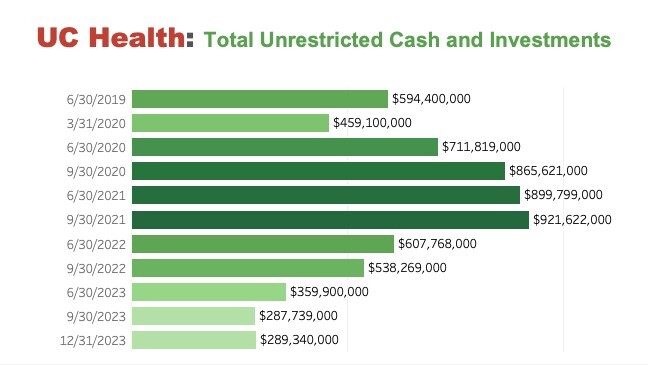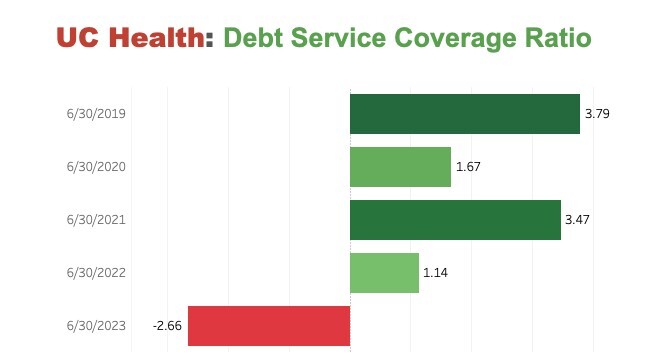CINCINNATI — The academic health system at the University of Cincinnati is close to finalizing an arrangement with Medicaid that would bring $279 million in supplemental payments to UC Health, which has been struggling to overcome $256 million in operating losses between July 2021 and December of last year.
Ohio lawmakers required the state’s Medicaid director to establish a hospital-directed payment program for UC Health as part of Ohio’s two-year budget bill last June. It would let UC Health transfer money to the state so it can draw down federal matching funds before UC Health gets all the money back in the form of increased Medicaid payments.
University of Cincinnati trustees signed off on the deal March 26. Now, it’s up to the Centers for Medicare & Medicaid Services, or CMS.
“We’re still waiting on final approval for that, but we’re confident we’re going to get it,” said UC Health CEO Cory Shaw. “Everyone understands that what we do is essential. We can’t be irresponsible about our cost and our price structure but at the same time, we’ve got to make an investment to ensure that what we do is available not only today but over the next decade.”

The WCPO 9 I-Team has been looking into UC Health’s financial situation because of a recent report by S&P Global, which downgraded its debt rating on the 10,000-employee system that includes UC Medical Center, West Chester Hospital, University of Cincinnati Physicians and Drake Center in Hartwell.
S&P reduced UC Health’s rating to BBB- with a negative outlook on March 19, citing “significant deterioration in unrestricted reserves and days' cash on hand.” The downgrade brought UC Health’s rating to one notch above junk-bond status. One more downgrade could dramatically increase the health system’s financing costs and worsen its financial condition. Although S&P praised UC Health for reducing its operating losses in 2023, it said the pending Medicaid deal was critical to its recovery.
“UC Health is likely to continue to generate operating losses through the outlook period absent funds from the Ohio DPP, which could result in further deterioration to an already very weak balance sheet,” said the report.
In a 30-minute interview, Shaw said UC Health’s financial recovery is well established, even without a directed payment program.
“Three of the last four months, we’ve actually produced a positive operating margin,” Shaw said. “Our forecast is for next year we’re going to be in a position where we’ll be performing financially at the level we expect to.”

Draining those budget reserves
Shaw relocated to Cincinnati from Nebraska, where he was chief operating officer for a $2.2 billion academic health system affiliated with the University of Nebraska in Omaha.
Shaw’s hiring was announced in October 2022. Before he arrived in January 2023, UC Health had already hired “a top-tier independent consultant to provide recommendations to improve operational performance,” according to financial filings provided to bondholders.
The problem was that UC Health was blowing through a $921 million pile of unrestricted cash and investments that grew during the pandemic, thanks to stimulus funding and a $208 million bond issue in April 2020. In the two years ending September 2023, UC Health spent more than $600 million of that war chest.

Some of the money was spent on “premium pay, overtime, use of temporary personnel for nursing staffing,” according to filings. A $136 million Medicare Advance Payment that UC Health received in 2020 was repaid in each of the next three years. And UC Health opted not to delay more than $275 million in construction projects to expand its emergency room, open new surgery units and establish a blood cancer healing center in the former Shriners Hospital building.
"These investments will ensure that the right level of patient care is provided not only today but into the coming decades," UC Health spokeswoman Amanda Nageleisen said. "Delaying the project would also have increased the eventual cost."
UC Health's budget problems drew scant attention in Cincinnati. Hospitals all over the country were struggling with rising operating costs, thanks to labor shortages and rising prices on supplies after the pandemic. But the impact on the health system’s balance sheet is now clear.
In February 2023, Moody’s Investors Service issued the first of two ratings downgrades on UC Health debt, citing “significantly escalating operating losses.” S&P warned that UC Health would violate a bond covenant requiring to it earn enough net income to cover at least 1.1 times its annual debt service.

UC went from a $106 million operating profit in the 12 months ending June 2021 to an operating loss of $156 million for the same period in 2023. It had 171 days of cash on hand in 2021, but only 56 in 2023. Its debt-service coverage ratio fell from 1.14 to -2.66 in 2023.
The numbers meant Shaw had to make some painful cuts.
“We took about a third of our leadership team out,” Shaw said. “In addition, we realigned responsibilities across our leadership team in a way that allowed us to get people focused on the areas that were the most important to us.”
UC Health has spent more than $41 million on restructuring costs since June 2022. S&P estimated those efforts will have a positive impact of $163 million on UC Health.
“This has been done with significant cost-cutting initiatives related to service line and supply efficiencies as well as a reduction in previously needed premium pay and agency staff,” S&P wrote in its March 19 report. “In addition, the team has sought several revenue opportunities, including increased revenue from pharmacy operations.”

'Such a good deal from Washington'
The recovery effort got a huge assist from Ohio lawmakers last summer. They committed $5 million to UC Health’s emergency room expansion and $8 million to the blood cancer healing center. And they got the ball rolling on a directed payment program for UC Health.
“We said, ‘OK.’ I mean, why not?,” said Rep. Bill Seitz, a Green Township Republican. “University Hospital is the only level one trauma hospital in our area. They have many specialties (in which) they are the only game in town. So, you know, we wanted to be helpful.”
Seitz pushed for language in Ohio’s two-year budget bill to require a hospital-directed payment program for “nonprofit hospitals in Hamilton County that are affiliated with a public medical school and that have a Level 1 trauma center.” A fiscal impact statement said the arrangement would bring $93 million in federal matching funds to UC Health in the 12 months ending June 2024, $185.9 million more by June 2025.
The enabling legislation said the program would be funded “only to the extent that local funds are available for the nonfederal share of the costs” and “limits the payment amounts to not more than the average commercial level paid for inpatient and outpatient services under the care management system.”
Those distinctions are important because it keeps the state from spending its own money on the program and allows UC Health to be compensated at a “commercial rate” that’s roughly three times what Medicaid typically pays.
“Politicians throughout many states know that they get such a good deal from Washington that sometimes they want to direct that money to their favorite industries,” said Rea Hederman, vice president of policy at The Buckeye Institute. “The Medicaid program is a risk for the safety of the American taxpayer because state politicians can then pass on cost to Washington. They don’t have to raise Ohio taxes because taxpayers in Florida, California and New York will help pay for this program. The problem is that officials are doing the exact same thing” in other states.
More than 1,000 directed payment programs have been approved by CMS since the federal agency first authorized them in 2016, according to CMS analysis published in the Federal Register in May 2023. It estimated directed payments totaled $52 billion in 2022, more than 6% of all Medicaid expenditures.
“From 2016 through 2022, SDPs (supplemental directed payments) were a significant factor in Medicaid expenditure growth,” the agency reported. “Total benefit spending increased at an average annual rate of 6.3 percent per year from 2016 through 2022; excluding SDPs, benefit spending grew at an average rate of 5.1 percent.”
In a December 2023 report, the Government Accountability Office said “states have made widespread use of directed payments” to “increase payments to safety net providers to ensure beneficiary access.” It criticized CMS for having “weak fiscal guardrails” and urged it to be more transparent about how it evaluates applications and monitors results.
Medicaid deal could restore growth
Shaw has no doubt the new Medicaid money will be put to good use.
“For patients that don’t have as many choices, and certainly in urban Cincinnati, we’re it. And we embrace that role,” Shaw said. “On a national level, there’s only about seven hospitals that are similar in size and scale and take care of the same level of clinical and social and economic complexity of patients as (UC Medical Center). We talk about that with people locally. We talk about that with our elected officials in Columbus. They all recognize that.”
Shaw argues UC Health provides other benefits to the region that warrant Medicaid’s increased investment.
“The next generation of medical students, nursing students, pharmacists, health science professionals in all those unique disciplines, we’re their primary teaching site. So, it’s critical,” Shaw said. “About a hundred thousand come to our emergency departments, here and up at West Chester on an annual basis. And then in addition, about 6500 patients get transferred a year from other hospitals across the region to one of our facilities, to get care that they can’t get in their local facilities.”
With $279 million in additional Medicaid funding, UC Health can get back into growth mode, resuming a long-sought goal of securing a National Cancer Institute designation.
Shaw said UC Health is “getting close” to reaching its $100 million fundraising goal for NCI designation and has “aspirations to do more.” Cincinnati is one of the largest cities without an NCI designation, which opens the door to millions in additional research funding. Columbus attained that status in 1976, and Cleveland in 1987.
“In order for us to achieve NCI-designation, which we will do, it’s going to require a combination of our own work as well as partnerships with local, state government (and) many of our supporters in the community,” said Shaw. “We’re just beginning a strategy process where we’re going to develop a vision for the next five to 15 years that will more fully inform what the next target is for us, in terms of raising funding to support the NCI designation.”





